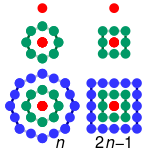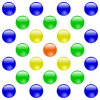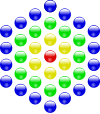عدد ممركز مضلع
العدد الممركز المضلع هو عدد شكلي مشكل بوضع نقطة في المركز ومن ثم تحاط هذه النقطة بطبقات من المضلعات لها عدد ثابت من الأطراف، بحيث أن كل ضلع في الطبقة الجديدة يزيد بنقطة عن الضلع في الطبقة السابقة له.
أمثلة

Each centered k-gonal number in the series is k times the previous triangular number, plus 1. This can be formalized by the expression , where n is the series rank, starting with 0 for the initial 1. For example, each centered square number in the series is four times the previous triangular number, plus 1. This can be formalized by the expression .
These series consist of the
- عدد ممركز مثلثي 1, 4, 10, 19, 31, 46, 64, 85, 109, 136, 166, 199, ... (OEIS: A005448),
- عدد ممركز مربعي 1, 5, 13, 25, 41, 61, 85, 113, 145, 181, 221, 265, ... (OEIS: A001844),
- عدد ممركز مخمسي 1, 6, 16, 31, 51, 76, 106, 141, 181, 226, 276, 331, ... (OEIS: A005891),
- عدد ممركز مسدسي 1, 7, 19, 37, 61, 91, 127, 169, 217, 271, 331, 397, ... (OEIS: A003215), which are exactly the difference of consecutive cubes, i.e. n3 − (n − 1)3,
- عدد ممركز مسبع 1, 8, 22, 43, 71, 106, 148, 197, 253, 316, 386, 463, ... (OEIS: A069099),
- عدد ممركز مثمني 1, 9, 25, 49, 81, 121, 169, 225, 289, 361, 441, 529, ... (OEIS: A016754), which are exactly the odd squares,
- عدد ممركز تساعي 1, 10, 28, 55, 91, 136, 190, 253, 325, 406, 496, 595, ... (OEIS: A060544), which include all even perfect numbers except 6,
- عدد ممركز عشاري 1, 11, 31, 61, 101, 151, 211, 281, 361, 451, 551, 661, ... (OEIS: A062786),
- centered hendecagonal numbers 1, 12, 34, 67, 111, 166, 232, 309, 397, 496, 606, 727, ... (OEIS: A069125),
- centered dodecagonal numbers 1, 13, 37, 73, 121, 181, 253, 337, 433, 541, 661, 793, ... (OEIS: A003154), which are also the star numbers,
and so on.
The following diagrams show a few examples of centered polygonal numbers and their geometric construction. Compare these diagrams with the diagrams in Polygonal number.
| centered triangular number |
centered square number |
centered pentagonal number |
centered hexagonal number |
|---|---|---|---|

|

|

|

|
Centered square numbers
| 1 | 5 | 13 | 25 | |||
|---|---|---|---|---|---|---|
Centered hexagonal numbers
| 1 | 7 | 19 | 37 | |||
|---|---|---|---|---|---|---|
Formulas
As can be seen in the above diagrams, the nth centered k-gonal number can be obtained by placing k copies of the (n−1)th triangular number around a central point; therefore, the nth centered k-gonal number is equal to
The difference of the n-th and the (n+1)-th consecutive centered k-gonal numbers is k(2n+1).
The n-th centered k-gonal number is equal to the n-th regular k-gonal number plus (n-1)2.
Just as is the case with regular polygonal numbers, the first centered k-gonal number is 1. Thus, for any k, 1 is both k-gonal and centered k-gonal. The next number to be both k-gonal and centered k-gonal can be found using the formula:
which tells us that 10 is both triangular and centered triangular, 25 is both square and centered square, etc.
Whereas a prime number p cannot be a polygonal number (except the trivial case, i.e. each p is the second p-gonal number), many centered polygonal numbers are primes. In fact, if k ≥ 3, k ≠ 8, k ≠ 9, then there are infinitely many centered k-gonal numbers which are primes (assuming the Bunyakovsky conjecture). Since all centered octagonal numbers are also square numbers, and all centered nonagonal numbers are also triangular numbers (and not equal to 3), thus both of them cannot be prime numbers.
Sum of reciprocals
The sum of reciprocals for the centered k-gonal numbers is[1]
- , if k ≠ 8
- , if k = 8
References
- Neil Sloane & Simon Plouffe (1995). The Encyclopedia of Integer Sequences. San Diego: Academic Press.: Fig. M3826
- Eric W. Weisstein, Centered polygonal number at MathWorld.
- F. Tapson (1999). The Oxford Mathematics Study Dictionary (2nd ed.). Oxford University Press. pp. 88–89. ISBN 0-19-914-567-9.